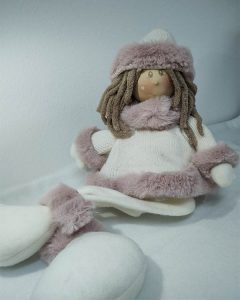Plush toys are no longer just toys for children: today they represent real pieces of furniture, ideal for adding a touch of originality and warmth to any room in the home. Choosing to place a soft toy furniture in your living room or bedroom means adding a decorative element capable of evoking childhood memories, transmitting serenity and, at the same time, giving a unique aesthetic to the spaces. In recent years, in fact, there has been a trend to use textile decorations – such as rag dolls, puppets or special pillows – to make rooms more cozy and personal.
This phenomenon does not only affect children’s bedrooms: more and more adults are choosing to decorate living rooms, studies and even reading corners with handmade soft toys made from natural or reclaimed materials. This is because soft furnishings, especially handmade ones, hold great emotional value and are often combined with an eco-friendly lifestyle, where attention to sustainability and product quality is paramount.
Trendy interior design plush toys share certain characteristics: attention to detail, the use of safe and nontoxic materials, and a personal style that blends seamlessly with their surroundings. From fabric bears with a vintage feel to rag dolls elaborately woven with sophisticated fabrics, each creation can become the focal point of a room or a simple touch of liveliness to enhance shelves, bookshelves, and sofas. Experimenting with shapes, sizes and colors allows you to express your personality creatively, making every home a truly unique place.
How to make a soft toy decoration: ideas and basic tips
Do-it-yourselfers who wish to try their hand at creating a decorative plush can follow some basic steps to achieve a pleasing and long-lasting result. First of all, it is important to carefully choose the design to be made: you can opt for a stylized character, a symbolic animal or even a fantasy object. Defining the aesthetics of the plush from the beginning helps to better plan the work and identify the materials needed.
Once you have decided on the subject, you move on to making the paper pattern. There are numerous ready-made patterns available in specialized magazines and websites, but nothing prohibits you from creating your own original pattern. If you prefer to start from a freehand drawing, simply bring the templates back to paper, cut them out and use them as a guide to cut the fabric. At this stage, it is essential to leave a seam allowance of a few millimeters so that the various pieces can be sewn together with ease.
To impart solidity and “body” to the plush, choosing the right stuffing is essential. You can use hypoallergenic synthetic fillings, which are ideal for a soft and voluminous look, but those who prefer an eco-friendly approach can opt for natural materials such as carded wool or kapok, a plant fiber derived from the fruits of the ceiba tree.
Finally,assembly requires manual dexterity and precision: you sew the various parts together following the seams on the reverse side, turn the plush upside down on the right side, and add details such as eyes, nose, buttons or embroidery decorations. With a little patience and dedication, you get unique creations that can add character to any home environment.
The most suitable materials for handcrafted and sustainable plush toys
The choice of materials plays a crucial role in making quality soft furnishings. Aiming for natural fabrics not only ensures a lower environmental impact, but also provides greater tactile comfort and an aesthetically pleasing finish. Organic cotton is a favorite among those who make handcrafted soft toys: soft to the touch, easy to work with, and free of harmful chemicals, it is the perfect base for creating cloth puppets and dolls that are also suitable for children.
Another interesting material is linen, prized for its durability, pleasantly rough feel and the sophistication it lends to any textile item. Those who wish to take an even more sustainable approach can take advantage of upcycling, salvaging old clothing, fabric scraps or disused bedspreads to give them new life. This practice, in addition to reducing waste, makes it possible to obtain furnishing plush with an original, one-of-a-kind look, making each piece truly one-of-a-kind.
On the stuffing front, as anticipated, there are environmentally friendly solutions that replace petrochemically derived synthetic materials. Carded wool, in addition to retaining heat, gives plushness and a special “fluffy” effect. Alternatively, one can opt for kapok, a light and breathable fiber, or corn fiber, a biodegradable stuffing that is increasingly used in handicrafts.
Thanks to these choices, soft furnishing toys not only become environmentally friendly, but also maintain a pleasing appearance over time, resisting wear and tear and keeping their shape intact.
Where to buy decorative plush toys: the offerings of FablesGreen
Not everyone has the passion or time to sew handmade plush toys at home. For those who prefer to buy ready-made products, the e-commerce FablesGreen.com is a valuable resource. Specializing in the creation of entirely handmade gift items – such as birth bows, rag dolls, and Christmas gifts–FabulousGreen also offers a section devoted to high-quality, sustainable soft toys for decorating.
Each plush available on Favole Green is the result of a meticulous manufacturing process, starting from the selection of natural or reclaimed fabrics to the attention to the smallest aesthetic details. Artisans often collaborate with local businesses, favoring an ethical and environmentally friendly approach. This means that, by purchasing a soft furnishing toy on FavoleGreen, you are supporting a short and transparent supply chain, where the quality and originality of the product are guaranteed by expert hands.
The range of furnishing soft toys on offer is wide and varied: they range from vintage-style cloth teddy bears, perfect for a retro-flavored living room, to minimal bunnies to place in a modern bedroom. There is no shortage of more elaborate creations, such as characters inspired by fairy tales or customized on-demand subjects, ideal for a meaningful gift. With the possibility of requesting variations in color, size or special details, each plush can be adapted to personal taste or the aesthetics of a given environment.
Why to choose handmade furniture plush and conclusions
Handmade furnishing soft toys are not simply decorative objects: they represent a true expression of creativity, a meeting of design and craftsmanship that makes each piece charged with meaning. In the context of a living room, bedroom or study nook, a handmade soft toy can become a symbol of a slower, more conscious and sustainability-conscious way of living.
From the creative idea to the sewing stage, each step encompasses passion and professionalism. Thanks to specialized e-commerce such as FablesGreen.com, you can discover a wide variety of soft furnishings in line with your tastes and environmentally friendly.
All in all, soft furnishings represent an increasingly popular trend, capable of combining aesthetics and green values. Whether you decide to make them yourself or buy them from a trusted artisan, these decorative accessories are able to enrich any room, transforming it into an intimate and cozy place. This is why, in the age of globalization and mass production, surrounding yourself with unique and sustainable products can really make a difference, both for your personal well-being and that of the planet.

